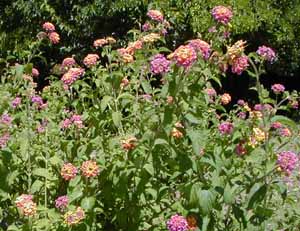
The genus Lantana, in the Family Verbenaceae, includes more than 150 species of hairy-leaved and often prickly-stemmed shrubs and herbaceous perennials native to the tropical Americas. Most are hardy only to USDA Zone 8. All produce verbena-like flowers in stalked clusters arising from the leaf axils or at the ends of branches. Spanish colonists were interested in lantanas first for their reputed medicinal value, using them to make infusions as a tonic for the stomach or to cure snake bites. Now most interest in these plants is for their colorful blossoms that are very attractive to butterflies and hummingbirds.

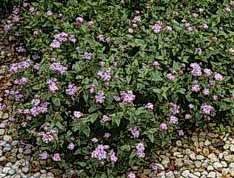
Common lantana (Lantana camara) is a small perennial shrub with yellow, orange or red flowers but as a fast-growing, profuse bloomer it (or its hybrids) this tender perennial is best treated as an annual in our area. Trailing lantana (Lantana montevidensis) is a low-growing, spreading plant that produces a profusion of lavender, purple or white flowers which also attract butterflies. It is good for baskets or training into standards.
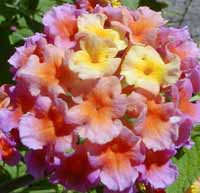
The flowers are borne in flat-topped clusters on a long stalk. Each individual flower is small and tubular. Depending on the variety, the flowers may be white, pink, or yellow, changing to orange or red. If successfully pollinated, plants produce fleshy berry-like green fruits that become bluish black. The unripe berries are poisonous and the leaves can cause contact dermatitis or minor skin irritation in some people. (Another detrimental aspect is the leaves usually have a disagreeable odor when rubbed or crushed.) Deer and rabbits avoid feeding on lantana.
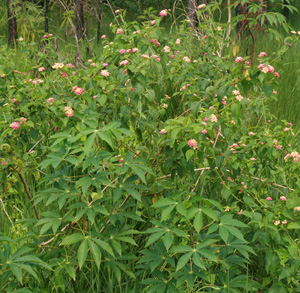
In some places lantanas are troublesome weeds, spread mainly by birds that are very fond of their juicy fruits. Lantana is considered an invasive weed in Hawaii, Florida, Texas, eastern Australia, the Galapagos Islands and other islands and areas.
This plant can be used in mixed beds or borders and is good in containers and hanging baskets. It can also be grown as a houseplant if you have enough light.
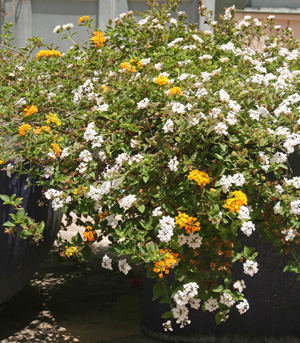
Lantana does best in full sun and hot temperatures in well drained soil. It is easy to grow and is heat, drought and sun-tolerant. Too much water and fertilizer will reduce bloom. In containers, fertilize once a month during the growing season. Plants in the ground should not need any fertilization. The plants should be deadheaded to encourage continuous bloom. You can clip the individual faded flowers, or trim the whole plant with hedge clippers.
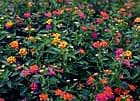
Lantana can be grown from seed or cuttings. Seedlings take a long time to bloom, however, so in our short season it is best to start with purchased plants or take hard wood cuttings in the fall to produce young plants for the following spring. Lantana is killed at 28° F, so must be protected from frosts and moved indoors for the winter if you wish to keep the plant.
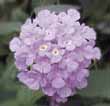
There are many named varieties and hybrids of lantana available that are more compact, bloom earlier, produce more colorful flowers, or hold their flowers better in bad weather than the “common” type. Some new varieties are also almost sterile (rarely set seed), which means deadheading is not as important for continuous bloom and it is unlikely to become invasive (although that’s not a concern in Wisconsin). Trailing lantanas typically have the best flowering, followed by mounding types and upright types, respectively. Some common varieties are listed here (however, lantana cultivar names are numerous and sometimes confused):
- ‘Confetti’ produces multicolored yellow, pink and magenta flowers.
- ‘Dallas Red’ has solid red flowers and blooms well.
- ‘Gold Mound’ has yellowish orange flowers, flowers well, and is resistant to early fruiting.
- ‘Imperial Purple’ is a trailing plant with many purple flowers.
- ‘Irene’ is a compact variety with intense magenta flowers tinged with lemon yellow and orange that do not wash out in strong sun.
- ‘Lemon Drop’ is a trailing plant that produces lots of yellowish white flowers, and is resistant to early fruiting.
-
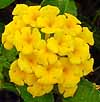
‘New Gold’ is one of the best new varieties.
‘New Gold’ is a small plant ( one foot tall and 2 feet wide) that is covered with dark golden-yellow 2-inch clusters of blooms which are produced just above the foliage. It is also completely fruitless. - ‘Patriot Dove Wings’ is a good bloomer with white flowers.
- ‘Patriot Firewagon’ is upright growing with red flowers.
- ‘Patriot Rainbow’ is a freeblooming, compact plant with magenta flowers.
- ‘Patriot Sunburst’ flowers freely.
- ‘Patriot Tangerine’ has hot orange flowers and consistent bloom.
- ‘Radiation’ has multicolored yellow and coral flowers with orange throats on plants 3-5 feet wide and high.
- ‘Samantha’ (‘Lemon Swirl’) has bright yellow flowers and variegated foliage, with a bright yellow band around each leaf.
- ‘Silver Mound’ has creamy flowers with a gold eye, produces lots of flowers on mounded plants and is resistant to early fruiting.
- ‘Spreading Sunset’ grows upright with vivid orange flowers with a coral center.
- ‘Sunny Daze’ is a trailing lantana with bright lavender and purple flowers.
- ‘Weeping White’ is a trailing plant with white flowers.
- ‘White Lightening’ is a trailing plant with lots of white flowers.
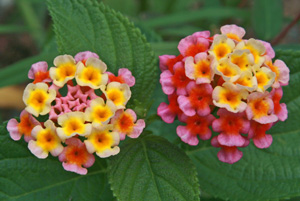
These varieties may not be readily available in Wisconsin; to get a particular variety, you may have to order from suppliers in southern states where lantana can be grown outdoors and different types are more plentiful as perennials.
– Susan Mahr, University of Wisconsin – Madison





 Marigolds
Marigolds Create a Butterfly Garden
Create a Butterfly Garden Plant Flowers to Encourage Beneficial Insects
Plant Flowers to Encourage Beneficial Insects Forcing Bulbs
Forcing Bulbs


